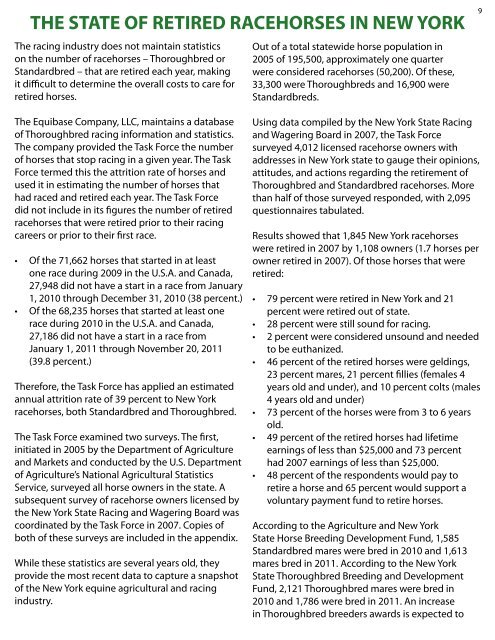Retired Racehorses
tfrr_reportandappendicesfinal
tfrr_reportandappendicesfinal
- No tags were found...
Create successful ePaper yourself
Turn your PDF publications into a flip-book with our unique Google optimized e-Paper software.
THE STATE OF RETIRED RACEHORSES IN NEW YORK 9<br />
The racing industry does not maintain statistics<br />
on the number of racehorses – Thoroughbred or<br />
Standardbred – that are retired each year, making<br />
it difficult to determine the overall costs to care for<br />
retired horses.<br />
Out of a total statewide horse population in<br />
2005 of 195,500, approximately one quarter<br />
were considered racehorses (50,200). Of these,<br />
33,300 were Thoroughbreds and 16,900 were<br />
Standardbreds.<br />
The Equibase Company, LLC, maintains a database<br />
of Thoroughbred racing information and statistics.<br />
The company provided the Task Force the number<br />
of horses that stop racing in a given year. The Task<br />
Force termed this the attrition rate of horses and<br />
used it in estimating the number of horses that<br />
had raced and retired each year. The Task Force<br />
did not include in its figures the number of retired<br />
racehorses that were retired prior to their racing<br />
careers or prior to their first race.<br />
• Of the 71,662 horses that started in at least<br />
one race during 2009 in the U.S.A. and Canada,<br />
27,948 did not have a start in a race from January<br />
1, 2010 through December 31, 2010 (38 percent.)<br />
• Of the 68,235 horses that started at least one<br />
race during 2010 in the U.S.A. and Canada,<br />
27,186 did not have a start in a race from<br />
January 1, 2011 through November 20, 2011<br />
(39.8 percent.)<br />
Therefore, the Task Force has applied an estimated<br />
annual attrition rate of 39 percent to New York<br />
racehorses, both Standardbred and Thoroughbred.<br />
The Task Force examined two surveys. The first,<br />
initiated in 2005 by the Department of Agriculture<br />
and Markets and conducted by the U.S. Department<br />
of Agriculture’s National Agricultural Statistics<br />
Service, surveyed all horse owners in the state. A<br />
subsequent survey of racehorse owners licensed by<br />
the New York State Racing and Wagering Board was<br />
coordinated by the Task Force in 2007. Copies of<br />
both of these surveys are included in the appendix.<br />
While these statistics are several years old, they<br />
provide the most recent data to capture a snapshot<br />
of the New York equine agricultural and racing<br />
industry.<br />
Using data compiled by the New York State Racing<br />
and Wagering Board in 2007, the Task Force<br />
surveyed 4,012 licensed racehorse owners with<br />
addresses in New York state to gauge their opinions,<br />
attitudes, and actions regarding the retirement of<br />
Thoroughbred and Standardbred racehorses. More<br />
than half of those surveyed responded, with 2,095<br />
questionnaires tabulated.<br />
Results showed that 1,845 New York racehorses<br />
were retired in 2007 by 1,108 owners (1.7 horses per<br />
owner retired in 2007). Of those horses that were<br />
retired:<br />
• 79 percent were retired in New York and 21<br />
percent were retired out of state.<br />
• 28 percent were still sound for racing.<br />
• 2 percent were considered unsound and needed<br />
to be euthanized.<br />
• 46 percent of the retired horses were geldings,<br />
23 percent mares, 21 percent fillies (females 4<br />
years old and under), and 10 percent colts (males<br />
4 years old and under)<br />
• 73 percent of the horses were from 3 to 6 years<br />
old.<br />
• 49 percent of the retired horses had lifetime<br />
earnings of less than $25,000 and 73 percent<br />
had 2007 earnings of less than $25,000.<br />
• 48 percent of the respondents would pay to<br />
retire a horse and 65 percent would support a<br />
voluntary payment fund to retire horses.<br />
According to the Agriculture and New York<br />
State Horse Breeding Development Fund, 1,585<br />
Standardbred mares were bred in 2010 and 1,613<br />
mares bred in 2011. According to the New York<br />
State Thoroughbred Breeding and Development<br />
Fund, 2,121 Thoroughbred mares were bred in<br />
2010 and 1,786 were bred in 2011. An increase<br />
in Thoroughbred breeders awards is expected to


